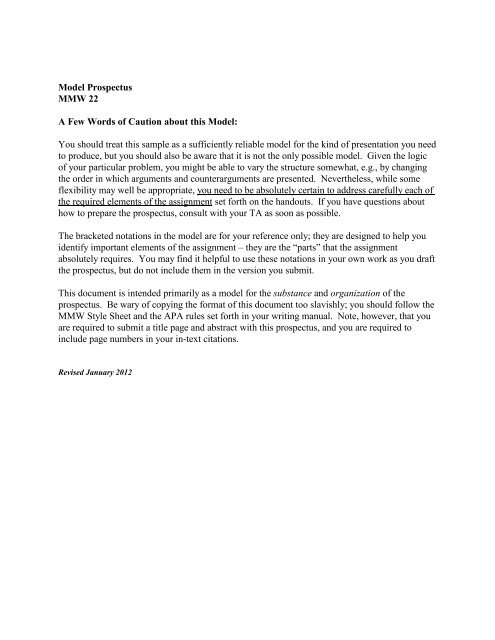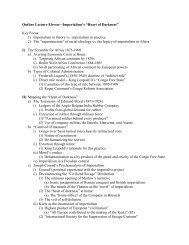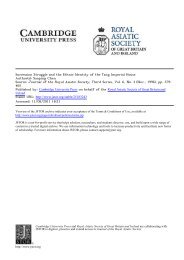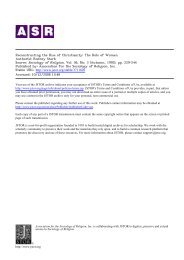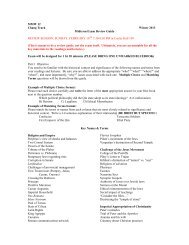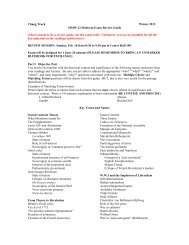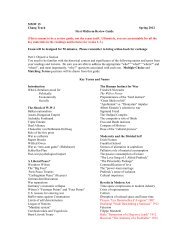Sample Prospectus
Sample Prospectus
Sample Prospectus
You also want an ePaper? Increase the reach of your titles
YUMPU automatically turns print PDFs into web optimized ePapers that Google loves.
Model <strong>Prospectus</strong><br />
MMW 22<br />
A Few Words of Caution about this Model:<br />
You should treat this sample as a sufficiently reliable model for the kind of presentation you need<br />
to produce, but you should also be aware that it is not the only possible model. Given the logic<br />
of your particular problem, you might be able to vary the structure somewhat, e.g., by changing<br />
the order in which arguments and counterarguments are presented. Nevertheless, while some<br />
flexibility may well be appropriate, you need to be absolutely certain to address carefully each of<br />
the required elements of the assignment set forth on the handouts. If you have questions about<br />
how to prepare the prospectus, consult with your TA as soon as possible.<br />
The bracketed notations in the model are for your reference only; they are designed to help you<br />
identify important elements of the assignment – they are the “parts” that the assignment<br />
absolutely requires. You may find it helpful to use these notations in your own work as you draft<br />
the prospectus, but do not include them in the version you submit.<br />
This document is intended primarily as a model for the substance and organization of the<br />
prospectus. Be wary of copying the format of this document too slavishly; you should follow the<br />
MMW Style Sheet and the APA rules set forth in your writing manual. Note, however, that you<br />
are required to submit a title page and abstract with this prospectus, and you are required to<br />
include page numbers in your in-text citations.<br />
Revised January 2012
Running head: PAPER TITLE IN ALL CAPS FEWER THAN 50 CHARACTERS 1<br />
Paper Title<br />
Your Name<br />
Section Z01<br />
Assignment Title or Number<br />
Date Due
TITLE OF PAPER USING FEWER THAN 50 CHARACTERS 2<br />
Abstract<br />
Your paper is required to have an abstract. Please write one here. A good abstract is a<br />
brief, comprehensive summary (usually one paragraph) of the contents of the prospectus; it<br />
allows your TA to survey the contents quickly and helps you to communicate the important<br />
elements of your prospectus (problem, thesis, and counter-arguments). You will reserve your<br />
discussion of evidence for the body of the prospectus.
TITLE OF PAPER USING FEWER THAN 50 CHARACTERS 3<br />
[Title:] Talleyrand and the Resurrection of France<br />
[Introduction to the topic] The Congress of Vienna marked the end of nearly two<br />
decades of continuous war in Europe. Napoleon had been defeated and the Bourbon monarch<br />
Louis XVIII had been restored in France. The Congress, led by the war-time alliance of Russia,<br />
Prussia, Austria, and Britain, sought to right the wrongs of the Napoleonic Era and craft a lasting<br />
peace in Europe. But a France defeated was not a France destroyed. [Problem/Question] Louis<br />
XVIII, as the newly crowned monarch, sent Charles Maurice de Talleyrand-Perigord to ensure<br />
that French interests would not be unduly violated at Vienna. According to the king, Talleyrand<br />
was the only man in France with the intelligence, stature, and cunning to prevent France from<br />
being pillaged by the bitter enemies of Napoleon's wars (Blinn, 1935, p. 151). Talleyrand felt<br />
that the creation of a European “balance of power,” with France as an integral component, would<br />
pay enormous dividends by providing France with a safe and secure Europe in which to flourish.<br />
Naturally, as the representative of a defeated and maliciously-hated nation, Talleyrand had his<br />
work cut out for him. How well did Talleyrand negotiate French political interests and advance<br />
his belief in a European “balance of power” at the Congress of Vienna? [Thesis] In response to<br />
this question, I will argue that Talleyrand successfully articulated his notion of the balance of<br />
power and, through clever maneuvering, he helped secure France a strong position at the<br />
negotiating table in Vienna and in continental politics writ large. Although France had been<br />
resoundingly defeated on the battlefield, Talleyrand ensured that her interests would not be<br />
ignored in the new European order.<br />
[Different scholarly interpretations/counter-arguments] While some scholarship<br />
supports this interpretation of Talleyrand's legacy, there are plausible arguments that indicate that
TITLE OF PAPER USING FEWER THAN 50 CHARACTERS 4<br />
Talleyrand may not have been as cunning as he believed himself to be and that his efforts at<br />
Vienna may not have been as beneficial to France as he had hoped. Sometimes his grand notion<br />
of collective European security (underpinned by a balance of power) came at the expense of<br />
France's national interests. Talleyrand viewed the German states as hopelessly weak and divided<br />
and thus did not foresee that by supporting the Prussian acquisition of the Rhineland he was<br />
contributing to Prussia's regional dominance and to their ultimately successful attempts to unify<br />
much of the German lands. This eventual unification was capped in 1871 by the crushing defeat<br />
of France in the Franco-Prussian War and the crowning of Wilhelm I as German Emperor in the<br />
Palace of Versailles’s Hall of Mirrors (Blinn, 135, p. 157). A second possible misstep was his<br />
advice to Louis XVIII against a marriage alliance between his nephew, the Duke of Berry, and<br />
the Tsar's sister. Instead, Talleyrand negotiated a “Triple Alliance” with Britain and Austria to<br />
counter perceived Russian aggression (Harris, 2007, pp. 253- 244). According to some,<br />
Talleyrand put a European balance of power before French national interests. Sharp attacks came<br />
from multiple statesmen, such as Etienne-Denis Pasquier, who believed Talleyrand should have<br />
allied French interests to Russia (France's frequent partner prior to the Napoleonic Wars) instead<br />
of trying to counter the Tsar's claims over Poland (Harris, 2007, pp. 253-254). These statesmen<br />
argued that the strategic and territorial interests of Russia conflicted far less with those of France<br />
than the much more proximate empires of Britain and Austria. The third and arguably the<br />
greatest of Talleyrand's failures emerged with the Second Treaty of Paris. After Napoleon's<br />
Hundred Days, the Congress of Vienna drew up a particularly vicious and punitive treaty when it<br />
became clear that neither Talleyrand nor his master Louis XVIII could be trusted in their repeated<br />
assertions that the French people were tired of Napoleon (Chapman, 1998, p. 55).
TITLE OF PAPER USING FEWER THAN 50 CHARACTERS 5<br />
[Rebuttals] Despite these arguments, I argue that Talleyrand successfully used the<br />
platform of European balance of power to advance French political interests. Talleyrand<br />
effectively argued against the Austrian acquisition of Sardinia by raising the specter of Austrian<br />
dominance of northern Italy (Blinn, 1935, p. 144). When Talleyrand maneuvered France into the<br />
Triple Alliance with Britain and Austria to counteract growing Russian influence, he did so in<br />
order to decrease border friction and turn bitter enemies into allies who would support France's<br />
international agenda (Ferrero, 1941, p. 275). While France had fought Britain and Austria on and<br />
off for nearly 200 years prior to the formation of the Triple Alliance, France has not since been<br />
involved in a major conflict with either country. Furthermore, Talleyrand used his adept<br />
diplomatic skills to keep the defeated France at the negotiating table by insinuating that only<br />
France would be capable of forcing Tsar Alexander to give up his 1813 alliance with Prussia and<br />
enter into a broader European balance of power (Chapman, 1998, pp. 18-19). In order to prevent<br />
a future conqueror (à la Napoleon) from destabilizing this new system, Talleyrand used his<br />
influence to delegitimize the “right to sovereignty by force” within the Congress and ensure that<br />
the other powers would not tolerate aggressive or illegitimate conquests (Dwyer, 2002, p. 146).<br />
[Conclusion/Explanation of Significance] Despite Napoleon's defeat, Talleyrand<br />
ensured that France would continue to have a voice in European affairs through his collective<br />
security scheme. He maintained that this system was in France's long-term interests and spurned<br />
warfare as an effective political tactic. Talleyrand argued that war inflicted nearly as much<br />
damage on the conqueror as on the conquered. Even if Napoleon had been victorious, he would<br />
have left Europe in a perpetually unstable condition with the threat of war ever-looming.<br />
Talleyrand firmly believed that an unstable Europe was ultimately incompatible with a strong
TITLE OF PAPER USING FEWER THAN 50 CHARACTERS 6<br />
France. At Vienna, his unenviable task was to convince his colleagues that what France desired<br />
most was peace and security for all of Europe. This was particularly challenging given that<br />
France had been the greatest enemy of European security for the better part of twenty years.<br />
Eventually, he was successful in convincing the Congress that a Europe with well-established<br />
boundaries and a universal understanding that war would be detrimental to all parties could keep<br />
the power-hungry in check.<br />
The relative peace in Europe for a hundred years following the Napoleonic wars<br />
(with the struggle for German unification serving as a notable exception) is a testament to the<br />
enduring strength of the balance of power crafted at the Congress of Vienna under the guidance<br />
of Talleyrand. He was able to resurrect and secure French power in Europe through peace and<br />
the balance of power rather than through war and conquest.
TITLE OF PAPER USING FEWER THAN 50 CHARACTERS 7<br />
References<br />
Author, A.A. (Year of Publication). Title of work: Capital letter starts subtitle as well if there is<br />
one and is also used with Proper Nouns. Location: Publisher.<br />
Blinn, H. (1935) New light on Talleyrand at the Congress of Vienna. Pacific Historical Review<br />
4.2, 143-160. [Although this source was retained for use in this model, sources this old<br />
should only be used in consultation with your TA.]<br />
Chapman, T. (1998). The Congress of Vienna: Origins, processes, and results. London:<br />
Routledge.<br />
Dwyer, P.G. (2002). Talleyrand: Profiles in power. London: Pearson Education.<br />
Ferrero, G. (1941). The reconstruction of Europe: Talleyrand and the Congress of Vienna, 1814-<br />
1815. New York: G.P. Putnam’s Sons.<br />
Harris, R. (2007). Talleyrand: Betrayed and savior of France. London: John Murray, 2007.


